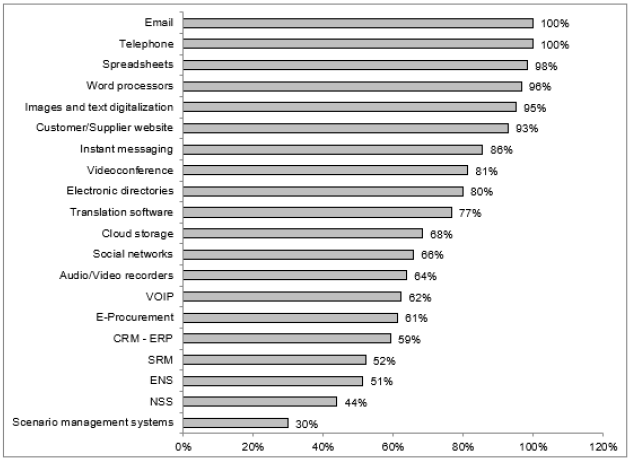Introduction.
Information and communication technologies have become a critical tool for data interchange nowadays, increasing relations between people and organizations worldwide, changing the dynamics of communications in international businesses, allowing the ubiquity and the presence among interlocutors regardless of geographical barriers.
In fact, ICT increases the performance of international trading processes for enterprises performing export or import processes (Cano & Baena, 2015) and promotes socio-economic development, whereby several countries justify efforts to increase the budget in ICT research and development (Gatautis, 2008). In this sense, it is possible to affirm that developed nations usually invest considerable resources for improving their technological environment and infrastructure, accelerating the expansion of digital technologies and taking advantage of these technologies (Hamner & Qazi, 2009). However, despite the different benefits of the internet and its remarkable growth in the last decade, due to the increase of devices offered by the market, only 54 % of the world population has internet access today. Castaldo et al. (2018) argue the existence of a positive correlation between economic growth and broadband diffusion, for which the development of public policy for promoting ICT must be supported in developing countries where economic limitations and social issues often interfere with the implementation and use of ICT in business processes (The World Bank, 2016).
The impact of ICT on country productivity seems increasingly relevant; in this way, different studies suggest that countries' ability to achieve higher economic growth may be related to higher rates of ICT investment versus those with modest investment rates (Hawash & Lang, 2020; Lechman & Anacka, 2022). Then, ICT has become an innovative solution for work practices and can improve the economic performance in internationalized firms, but such change is evident only when the new technologies have been incorporated into organizational and process innovations (Cassetta et al., 2020). Their main benefits are positively related to skills for staff, and similarly, different types of effects on training can be evidenced, as well as on the composition of the workforce. Therefore, modern organizational practices such as ICT and other informatics resources improve productivity and organizational change which is more common in new successful internationalized firms (Bayo-Moriones et al., 2008; Giuri et al., 2008; Gbadegeshin et al., 2019). Precisely, the Pacific Alliance has developed a new policy about ICT offering benefits to enterprises belonging to this trade bloc, allowing better governance practices for countries such as Chile, Colombia, Mexico, and Peru in terms of efficiency, transparency, and socio-economic development (Pawar, 2009). Thus, the Pacific Alliance is promoting efficient tools to facilitate the trading negotiation process between exporters and importers for achieving a more significant number of international sale contracts, supporting the exchange of goods and services among the enterprises of this trade bloc.
Accordingly, some studies show that Internet-based ICT is increasingly used and implemented in many companies due to the optimization of business processes, providing effective communication, low-cost information processing, and an innovative way for international negotiations (Cano & Baena, 2015; Dastjerdi, 2016). These situations motivate the Pacific Alliance to consider the remarkable growth indicators of this trading bloc during the last years, leading the member countries to stand out globally at political levels (Aranda, 2015). Seatzu (2015) adds that this economic integration initiative is one of the most relevant economic integrations in Latin America, which is currently rising as a new influential trading bloc with remarkable potential. Therefore, this study aims to identify the most used ICT in the international trade negotiation into the Pacific Alliance enterprises and determine the negotiation phases that need most the use of ICT for its performance.
Literature review
One of the economic integration processes that has captured the attention of the international community has been the Pacific Alliance. It is estimated to have a market size of over 200 million consumers with growing potential purchasing power and business opportunities in mining, chemicals, textiles, apparel, and agroindustry (Hutchings & Suri, 2015). On the other hand, Bakos and Brynjolfsson (1993) stated that many companies worldwide had changed the paradigm for reaching new contract arrangements through the application of different bargaining techniques. Therefore, enterprises can adopt ICT to perform their trading negotiation process; however, they need to learn about these tools, identify the right one for each operation, and use them efficiently and effectively to get better results (Loukis et al., 2008).
Besides supporting the international trading negotiation processes, ICT can improve other internal issues regarding resource planning and the visibility of operations, especially in developing countries (Yamin & Sinkovics, 2013). For this reason, the network readiness of a country indi cates the ability of its principal stakeholders to leverage the potential of ICT. Therefore, these can be useful to reduce the digital gap existing in their communities and help optimize the market conditions for foreign direct investment, influencing the economic growth positively (Gholami et al., 2006; Kafetzopoulos, 2022; Lechman & Anacka, 2022). Consequently, enterprises get many benefits from ICT by reducing the total time and costs of international trade operations, generating new business opportunities, and increasing international sale contracts (Cano & Baena, 2015).
However, it is essential to remark that security remains to be a noteworthy obstacle for ICT implementation because some users show distrust with these technologies due to some critical handicaps related to computer security, representing a threat that could damage the public's confidence(Agirre et al., 2018; Tan et al., 2009).In addition, it could also become a curse for them in terms of cybersecurity threats, which can lead to financial losses and reputational damage (Mohammed et al., 2020). It is important to mention that issues related to the counterpart, the knowledge of these technologies, the infrastructure requirements, and even the skills for handling these tools are other barriers to implement ICT in business processes (Galloway et al., 2004; Cano & Baena, 2017; Cassetta et al., 2020). Additionally, the financial constraints appear as mainly barriers in the usage of these technologies (Wolszczak-Derlacz, 2021).
Despite this situation, most of the literature shows the benefits of ICT adoption into enterprises, considering these technologies can positively influence business performance by incorporating innovative work practices (Bayo-Moriones et al., 2013). Other studies reveal that email and phone are the most widely used ICTs in the negotiation phases of international trade for completing contract arrangements among enterprises (Thompson & Nadler, 2002). In this sense, it has been proven that ICTs improve the decision making process, lead to the development of successful businesses, diversify business opportunities, enable the establishment of commercial relationships and reduce the time of the trading negotiation process. Even the frequency of ICT training encourages talent in these technologies and improves firm performance (Cano & Baena, 2018). Therefore, ICT offers different alternatives to improve the competitiveness of enterprises, and for this reason, many governments work truly hard to raise confidence in technology users and to increase the implementation of ICT among small and medium-sized enterprises (Morgan et al., 2006). Likewise, ICT implementation depends on particular issues such as the perceived ease of use and the perceived usefulness. The perceived usefulness explains the user's perception about how these technologies increase the work performance, and the perceived ease of use describes the attitude of the user about how these technologies decrease the work efforts (Davis, 1989; Venkatesh & Davis, 1997).
This approach forms the basis of the Technology Acceptance Model (TAM), but to guarantee the successful implementation of ICT, the TAM requires adopting new working methods and adapting existing skills to new usages (Selamat et al., 2013). For the international trading negotiation process, the TAM can be adopted in each of its three phases, called preparation, dialogue, and closure (Baena et al., 2015), justifying ICT implementation to achieve the required arrangements within international sale contracts. Figure 1 shows the phases of international negotiation and the TAM, highlighting how the TAM allows the evaluation of ICT in each of the phases mentioned above.
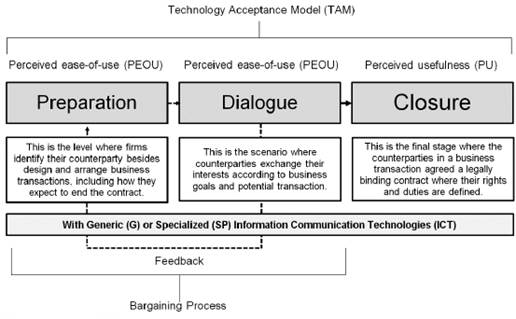
Source: Own elaboration based on Venkatesh and Davis (1997), Selamat et al. (2013), and Baena et al. (2015) Note. This model shows the articulation of the TAM framework with the international negotiation process.
Figure 1 TAM in the international negotiation phases
However, according to Pather and Abiodun (2017), it is necessary to face many challenges to overcome the issues related to ICT implementation because many organizations are unaware of all the benefits of adopting ICT. As shown in Table 1, currently, several ICT can be applied in companies according to each negotiation phase and technical requirements of users (Cano & Baena, 2015). Likewise, Cano and Baena (2017) also affirm that ICT can be classified as generic or specialized technologies according to the purpose of use, application to business processes, and customization to the operations of the international negotiation process.
Table 1 Characterization of ICT for the international negotiation process
| ICT | Complexity | Information | ICT | Negotiation phase | |
|---|---|---|---|---|---|
| of use | interchange* | approach** | Preparation Dialogue | Closure | |
| Blogs and forums | Low | A | G | ✓ - | - |
| Scenario management systems | High | A | SP | ✓ - | - |
| Electronic directories | Low | A | G | ✓ - | - |
| Customer/Supplier website | Low | A | G | ✓ - | - |
| Customer relationship management (CRM) | Medium | A | SP | ✓ ✓ | - |
| Enterprise Resource Planning (ERP) | High | A | SP | ✓ ✓ | - |
| Social networks | Low | S | G | ✓ ✓ | - |
| Spreadsheets | Low | S | G | ✓ ✓ | - |
| Supplier management system | Medium | A | SP | ✓ ✓ | - |
| Word processors | Low | A | G | ✓ ✓ | - |
| Cloud storage | Low | A | G | - ✓ | ✓ |
| Digitization of text and images | Low | A | G | - ✓ | ✓ |
| Electronic negotiation systems | High | A | SP | - ✓ | ✓ |
| (ENS) | |||||
| Low | A | G | - ✓ | ✓ | |
| Instant messaging (IM) | Low | A | G | - ✓ | ✓ |
| Negotiation support systems (NSS) | High | A | SP | - ✓ | ✓ |
| Telephone | Low | S | G | - ✓ | ✓ |
| Video conference | Low | S | G | - ✓ | ✓ |
| VOIP | Low | S | G | - ✓ | ✓ |
| E-Procurement | Medium | A | SP | ✓ ✓ | ✓ |
| Translation software | Low | A | G | ✓ ✓ | ✓ |
| *A: Asynchronous. S: Synchronous | |||||
| **G: Generic. SP: Specialized |
Source: Own elaboration based on Cano & Baena (2015)
Therefore, it is crucial to identify what types of ICT are being implemented in companies to establish if ICT with less complexity is implemented nowadays. Perhaps, on the contrary, the most used ICT are specialized technologies for the international negotiation process. Similarly, it is necessary to establish in which phases of the negotiation the companies require to implement ICT to support their operations and activities, and even establish the difference in ICT use among small, medium, and large companies belonging to the Pacific Alliance (Cano & Baena, 2018). In any case, considering the numerous advantages and specific characteristics of different organizational procedures, firms are trying to adopt ICT applications to support their businesses. Hence, the literature reviews for this type of study can help understand adequately theories, perspectives, empirical research, and case studies related to this matter, becoming increasingly important in business management (Ghobakhloo et al., 2012).
Materials and Methods
To identify the most used ICT in the international trading negotiation process into the Pacific Alliance enterprises, were selected 401 enterprises from Chile (15 %), Colombia (11 %), Mexico (65 %), and Peru (9 %) performing export and import operations, using stratified random sampling. The study's sample size guarantees a confidence level of 95 % and allows an error of 5 %. Telephone interviews were supported on a questionnaire that was addressed to managers and leaders of the international trade department on each enterprise. Likewise, this data compilation was developed by a specialized consulting center from Medellin Colombia. Hence, the survey structure showed some interesting answers for the research, which allowed identifying the behavior of ICT within the trading negotiation process in the companies of this trade bloc. Therefore, this research carried out a descriptive study or observational studies that describe some patterns and occurrences regarding some features related to most used ICT in the international trading negotiation process in the Pacific Alliance enterprises. In this way, Thyer (2010) adds that this approach is often the first step or initial inquiry into a new topic; all of this is to characterize and define according to some essential features. Secondly, the current research also carried out an ordered logistic regression that explains both the level of importance given to ICT in the negotiation process and the frequency of their use within the Pacific Alliance companies.
Features of the firms
Table 2 shows the main characteristics of the companies surveyed concerning their general distinguishing features and the main study variables. The general summary of the variables associated with the companies includes the country, declared age, size, the activity carried out, international activity, the stage of negotiation in which they use ICT the most, and their frequency of use. It can then be seen that most of the companies that completed the questionnaire are of Mexican origin, with more than 35 years of operating in the market. They are medium-sized, belonging to the manufacturing economic activity or secondary sector; they develop both export and import activities, and where preparation is the stage where ICT use is the highest.
Table 2 General features of the studied firms
| Main features | (%) | |
|---|---|---|
| Country | ||
| Chile | 14.94 | |
| Colombia | 11.14 | |
| Mexico | 65.06 | |
| Peru | 8.86 | |
| Years of existence | ||
| Less than 7 years | 10.89 | |
| Between 8 and 13 years | 14.68 | |
| Between 14 and 20 years | 24.05 | |
| Between 21 and 34 years | 21.77 | |
| More than 35 years | 26.08 | |
| Do not report | 2.53 | |
| Size | ||
| Small | 24.81 | |
| Medium | 49.62 | |
| Large | 25.57 | |
| Economic activity | ||
| Manufacturing, fabrication, transformation, secondary sector | 45.57 | |
| Basic raw materials, primary sector | 9.11 | |
| Services, marketing, tertiary sector | 40.51 | |
| Other | 4.81 | |
| International business | ||
| Imports | 26.58 | |
| Export | 12.41 | |
| Both | 61.01 | |
| Negotiation stage using ICT | ||
| Closure | 17.72 | |
| Dialogue | 33.16 | |
| Preparation | 49.11 | |
| Level of importance of ICT | ||
| Not very important | 4.30 | |
| Important | 27.85 | |
| Very important | 67.85 | |
| Frequencyofuse | ||
| Never/ra rely | 4.30 | |
| Sometimes | 7.59 | |
| Most of the time | 27.34 | |
| Always | 60.76 | |
Note. N=395. The summary corresponds to all complete data. Participants are mainly from Mexico, with an extensive experience in the international market, of medium size and who declare great importance to ICT and use it frequently.
Source: Own elaboration
Ordered logistic regression
Two functional forms were established to estímate the determinants of the response variable for explaining both the level of importance given to ICT in the negotiation process and the frequency of ICT use. For the first case, the levels established were 'not very important', 'important' and 'very important', assigning a numerical code of 1, 2, and 3. For the second specification, three levels were established: 'low', 'medium', and 'high', coded as 1, 2, and 3. The socio-business characteristics, the specific variables of use (frequency), and the negotiation stage were used as predictor variables. In the results section, only those statistically significant variables are reported after the variable selection process, which followed the stepwise selection procedure, taking as a reference the improvement in the log-likelihood and that the level of acceptance was below the 10% threshold. From the methodological point of view, several approaches are used to model categorical data (Agresti, 2003). When the explanatory variable expresses several levels, and these present a specific order, the ordered logistic model appears as an appropriate strategy (Fullerton, 2009). The estimation of the model was performed by means of R software; particularly the MASS package and its polr command (Ripley et al., 2013).
Results
From the data collected in the field study, Figure 2 displays that the most frequent ICTs in international negotiations process are email, telephone, spreadsheets, word processors, digital imaging and text software, and customers/suppliers website; results are consistent with those reported by Thompson and Nadler (2002). All this means that the most used ICT are generic technologies, widely used at the personal and business level. Therefore, it is essential to remark that specialized ICT such as Supplier Relationships Management (SRM), Electronic Negotiation Systems (ENS), Negotiation Support Systems (NSS), and scenario building software are not widely used in the trading negotiation process.
Thus, the results reinforce the proposals of previous studies stating that generic ICT and office suite software are used in more significant proportion than specialized ICT in international negotiation processes, suggesting an opportunity to implement specialized ICT to add value to the international negotiation by supporting the decision-making process.Figure 3 shows that 49 % of the companies use ICT in the preparation phase to collect and process information before making communications with the counterpart. Similarly, 33 % of companies prefer to use ICT in the dialogue phase to contact and register communications with international customers/ suppliers. On the other hand, only 18 % of the companies support the closure phase with ICT, whereby it is deduced that this stage is preferred to perform mainly face to face.
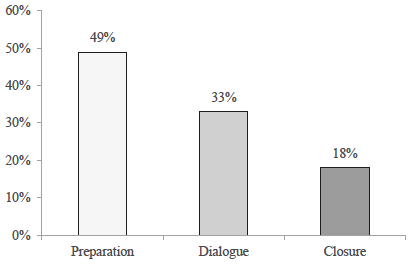
Source: Own elaboration
Figure 3 Use of ICT in the phases of the international negotiation process Source: Own elaboration
About the utilization of ICT in the trading negotiation process within the members of the Pacific Alliance, Figure 4 shows that in Peru, Mexico, and Chile, the companies recognize the need to use ICT mainly for the preparation phase. The behavior in Colombia is different, due to this country gives more relevance to the use of ICT in the dialogue phase. On the other hand, Peruvian enterprises prefer ICT equally for the dialogue and closure phase, while in Chile, Colombia, and Mexico, the dialogue phase is the one with less need for ICT support.
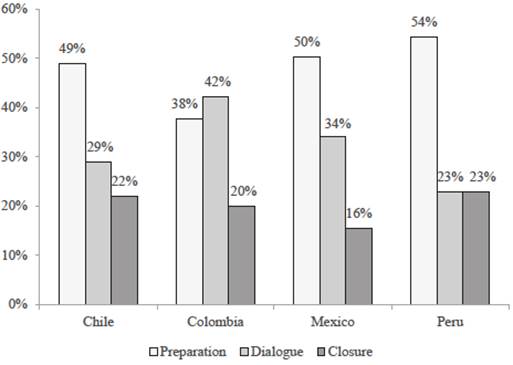
Source: Own elaboration Note. Reflects the percentage of responses in the three analyzed phases by country.
Figure 4. Need of ICT in the phases of the trading negotiation process
Regarding the use of ICT by company size, Figure 5 reveals the use of generic ICT in small, medium, and large companies, highlighting that email, telephone, spreadsheets, word processors, digital imaging and text, customer/ supplier websites, instant messaging, video conference, translation software, and VOIP present a similar use within each size of companies in the Pacific Alliance. In the case of cloud storage, and audio/video recorders, it is identified that large-sized companies use these technologies in a more significant proportion than small-sized companies, reflecting a greater formality in the registration of information and technologies allowing multiple users to access the information. Likewise, it is identified that the small-sized companies of the Pacific Alliance use social networks with greater intensity than large-sized companies, exceeding their percentage of use by approximately 11 percentage points, which may be due to a lower formality and technological development of the small-sized companies to contact counterparts for import or export operations.
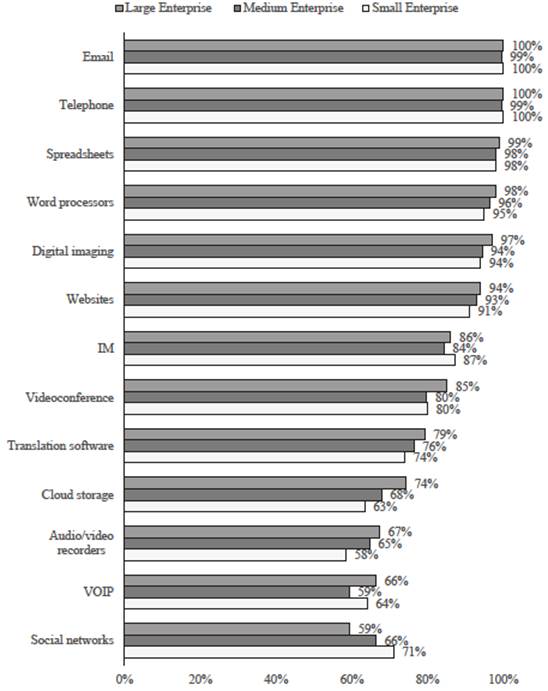
Source: Own elaboration Note. Multiple responses possible. Reflects the percentage of positive responses to each category according to company size.
Figure 5. Use of generic ICT in small, medium and large firms
Furthermore, Figure 6 shows that the utilization of specialized ICT for trading negotiation increases as the size of the companies increases, presenting significant differences between large and small-sized companies in the case of e-procurement, ERP, CRM, NSS, and scenario building software. Only in the case of ENS do medium-sized companies outperform large-sized companies and present a representative difference compared with small-sized companies. This situation is highlighted in Kafetzopoulos (2022) by pointing out how ERP and business information systems can be vital in launching new products for the international markets.
These results show an essential gap between large and small companies in the use and implementation of specialized ICT for international negotiation, representing an opportunity to improve decision-making support to obtain satisfactory contracts and agreements to perform import and export operations between the companies belonging to the Pacific Alliance. The above can be argued from the perspective of Ghobakhloo et al. (2012) which points to resource constraints and specific characteristics present in smaller firms.
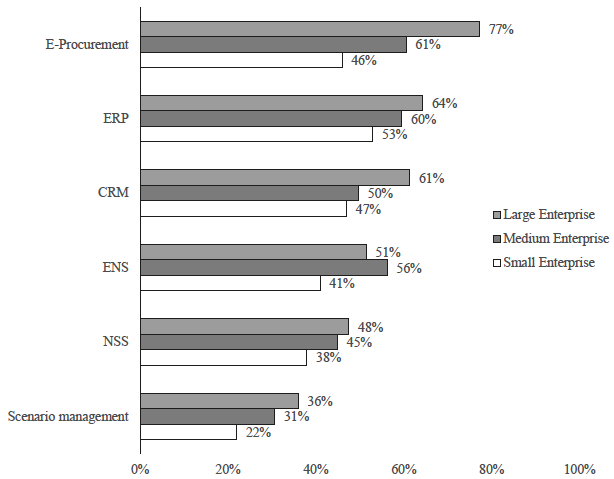
Source: Own elaboration Note. Multiple responses possible. Reflects the percentage of positive responses to each category according to company size.
Figure 6. Use of specialized ICT in small, medium and large firms
On the other hand, when ordered logistic regression was performed, the results suggest that the highest proportions of response in the variables analyzed were high in importance, high frequency, and negotiation stage in preparation (Table 3).
Table 3 Responses on levels, frequency and stage variables
| Levels | ||
|---|---|---|
| 1 | 2 | 3 |
| 17 | 110 | 268 |
| Frequency | ||
| 1 | 2 | 3 |
| 47 | 108 | 240 |
| Stage | ||
| Dialogue | Preparation | Closure |
| 131 | 194 | 70 |
Note. Reflects the number of responses for each of the explained variables used in the modeling. For the levels, three labels were established for 'not very important', 'important' and 'very important', assigning a numerical code of 1, 2, and 3. For the frequency, three labels were established: 'low', 'medium', and 'high', coded as 1, 2, and 3.
Source: Own elaboration
The above response frequencies can be interrelated and thus show the distribution of responses for the negotiation stage at each level of frequency and use, with a majority concentration at the very important level for the preparation and dialogue stages (Figure 7).
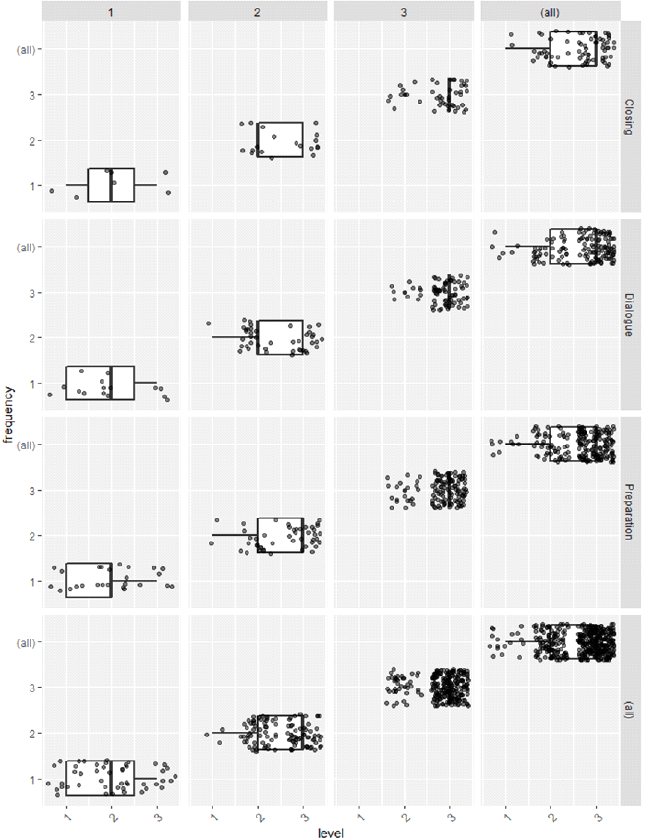
Source: Own elaboration Note. Each dot represents a company that fulfills all three dimensions. Own elaboration using R software.
Figure 7. Dispersión in frequency of use, level of use and stage of negotiation at which ICT are used
Two ordered logistic models were estimated for the determinants of the levels of importance and frequency of use to complement the descriptive analysis. Thus, after the variable selection process, the estimation yielded the following as statistically significant in the first case: firm size, digital technologies, SRM, and voice (Table 4). Thus, it was observed that, for small-sized companies, the probability of assigning a higher level of importance to ICT was 0.7361 compared to large companies, leaving the rest of the variables in the analysis constant. Meanwhile, for those firms that assigned higher levels in digital technologies, SMR, and voice, it was found that it is more likely to have higher ICT importance assignments at 0.3451, 0.2916, and 0.6991, respectively versus those that reported relatively lower importance.
Table 4 Variables associated with the explanation of the level of importance
| Variable | Value | Std. Error | t value | pvalue | |
|---|---|---|---|---|---|
| Medium | 0.1422 | 0.2865 | 0.4964 | 0.6196 | |
| Large | 0.7361 | 0.3691 | 1.9944 | 0.0461 | |
| Digital | 0.3451 | 0.2097 | 1.6456 | 0.0998 | |
| SRM | 0.2916 | 0.1482 | 1.9670 | 0.0492 | |
| Voice | 0.6991 | 0.1802 | 3.8798 | 0.0001 | |
| 2|3 | 0.1571 | 0.6606 | 0.2378 | 0.8120 | |
| 314 | 3.3851 | 0.6877 | 4.9225 | 0.0000 | |
| Residual deviation: 454.87 | P-value for parallel lines test P = 0,000 | ||||
| Akaike Information Criterion: 474.87 | |||||
Note. Output of the ordered logistic estimation model. Statistics are standardized regression coefficients; p values are presented in bold. Own elaboration using the MASS package from R software.
Source: Own elaboration
In the case of frequency, size and digital were also significant, and in addition to these, the topic of text appeared (Table 5). In this sense, small companies, compared to large ones, exhibit 0.9057 lower proportions of use; and it is shown that, for each lower level of perceived importance of digital and text technologies, the probabilities of lower frequency of use are multiplied by 0.7109 and 0.3779 times, respectively.
Tabla 5 Variables associated in the explanation of frequency of use
| Variable | Value | Std. Error | t value | pvalue |
|---|---|---|---|---|
| Medium | 0.3400 | 0.2438 | 1.3945 | 0.1632 |
| Large | 0.9057 | 0.3046 | 2.9738 | 0.0029 |
| Digital | 0.7109 | 0.1834 | 3.8762 | 0.0001 |
| Text | 0.3779 | 0.2120 | 1.7824 | 0.0747 |
| 2|3 | 0.0937 | 0.7081 | 0.1324 | 0.8947 |
| 314 | 1.2404 | 0.6931 | 1.7895 | 0.0735 |
| 4|5 | 2.9090 | 0.7084 | 4.1063 | 0.0000 |
| Residual deviation: 741.60 | P-value for parallel lines test P = 0,000 | |||
| Akaike Information Criterion: 755.60 | ||||
Note. Output of the ordered logistic estimation model. Statistics are standardized regression coefficients; p values are presented in bold. Own elaboration using the MASS package from R software.
Source: Own elaboration
Conclusions
The aim of the current research was to determine the ICT most commonly used in the international trade negotiation process of the Pacific Alliance firms. In line with the results of Thompson and Nadler (2002), the adoption of generic ICT to support the international negotiation process, where the use of email, telephone, spreadsheets, word processors, digital imaging software, and customer/ supplier websites. In this sense, the companies need to make the transition from the basic and traditional tools to be complemented with more advanced tools in the current era of technological digitization.
Thus, specialized ICT such as e-procurement, ERP, CRM, NSS, ENS, and scenario building software are not widely used in international trading negotiation. Whereby the companies in the Pacific Alliance should seize the benefits offered by these technologies to support the decision-making and enhance the efficiency and effectiveness of the international negotiation process. This incorporation and technological upgrading would allow companies not only to expand the launching portfolio of new attractive products in other markets as pointed out by Kafetzopoulos (2022), generating greater technological proficiency (Cano & Baena, 2018) that could derive a positive impact on their business performance (Bayo-Moriones et al., 2013).
The study also reveals that ICT are essential for each international negotiation phase, especially in the preparation phase, where these technologies offer different options to acquire, analyze, and organize information before contacting and communicating with the counterpart. Likewise, adopting an ordered logistic model, the study reveals that small companies, compared to large companies, show much lower ICT use proportions. This last can be explained in part by the lack of resources, knowledge, and training that small companies may have compared to large,consolidated firms due to their higher sales in international markets.
Similarly, it is shown that the perceived importance of ICTs among Pacific Alliance companies significantly influences the frequency of ICT use. Therefore, in general, public administrations and companies are interested in learning more about the positive effect of ICT on the productivity of organizations. Additionally, the study showed relevant gaps between large and small-sized companies of the Pacific Alliance in the use of specialized ICT, which invites to improve their dissemination, implementation, and acquisition with the support of governments, in order to overcome possible barriers related to high acquisition costs, training needs, and support infrastructure.
Finally, this research does not escape from some limitations that are important to make explicit. The study is more focused towards a listed set of ICT and the results may differ if we include new categories like internet of the things, artificial intelligence and blockchain. Another element to consider is the maturity (age) of the companies surveyed, which could account for the choice of basic and traditional technologies; perhaps a sample that considers born-global firms could show adoptions of more complex technologies. Likewise, the findings could contain some type of geographic bias towards Mexican firms that dominated the sample in numerical terms of quantity. In this way, future work on the topic could take into account these elements and incorporate new dimensions, other countries and young firms for validating new evidence.














